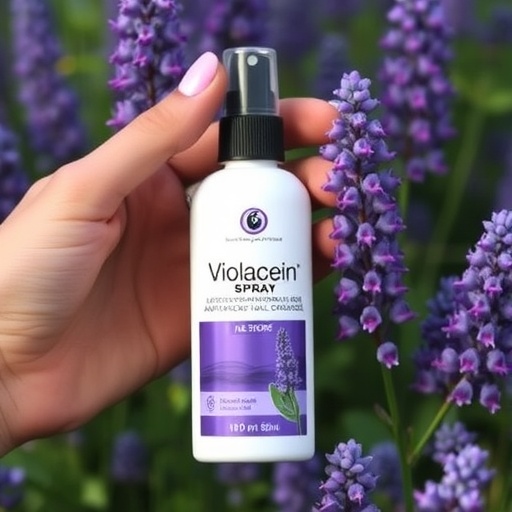Unleashing the Power of Violacein: A New Era in Antibacterial Innovations
In an era marked by the rise of antibiotic resistance, the quest for innovative antibacterial agents has never been more crucial. A groundbreaking study led by researchers Huanbutta et al. sheds light on a remarkable natural compound known as violacein, which showcases potent antibacterial properties and presents an exciting new avenue for topical applications. This compound, derived from a variety of microbial sources, has significant implications for treating various bacterial infections, positioning itself as a promising alternative to conventional antibiotics.
The significance of violacein stems from its unique chemical structure and intrinsic properties that allow it to combat a range of Gram-positive and Gram-negative bacteria. Unlike traditional antibiotics that are often associated with adverse side effects and resistance issues, violacein differentiates itself by functioning through a mechanism of action that disrupts bacterial cellular processes. This natural compound’s holistic potential not only targets pathogenic bacteria but also minimizes the risk of developing resistant strains, offering hope in the ongoing battle against bacterial infections.
In a startling revelation, the study details a novel application of violacein through the development of film-forming sprays designed for topical use. This innovative delivery system is crucial, as it allows for direct application onto affected areas while maintaining the compound’s efficacy. The film-forming property provides a protective barrier that enhances adherence to the skin, promotes sustained release of the active agent, and effectively combats infections localized on the surface, all while fostering a healing environment.
A key aspect that contributes to the effectiveness of this newly formulated spray is the biocompatibility of violacein. The study emphasizes that this natural agent is less likely to provoke inflammatory responses, making it an ideal candidate for use in wound healing and skin infections. This biocompatibility ensures patient safety while maximizing the therapeutic benefits, transforming the conventional approach to treating dermatological conditions challenging to resolve.
Moreover, the researchers extensively evaluated both the in vitro and in vivo efficacy of violacein within their innovative formulation. Laboratory tests highlighted significant reductions in bacterial counts, offering compelling evidence of its antibacterial prowess. Notably, the results indicated that violacein is exceptionally effective against antibiotic-resistant strains, which are increasingly prevalent in clinical settings. This finding reinforces the compound’s importance as a viable alternative in modern medicine’s antibiotic arsenal.
To further support its clinical applications, the study also examined the pharmacokinetic profile of violacein. Understanding how the body absorbs, distributes, metabolizes, and excretes this compound is vital for determining its safety and efficacy. The research findings demonstrated favorable pharmacokinetics, suggesting that violacein could be effectively utilized in clinical scenarios without causing systemic toxicity. Such attributes enhance the appeal of this natural compound and its formulation for therapeutic use.
As technology advances, the intersection of traditional medicine and modern science has paved the way for innovative approaches in combating infections. The incorporation of violacein into topical film-forming sprays is not merely a scientific triumph but heralds a new era in understanding how to harness natural compounds for addressing real-world health challenges. Researchers hope that this discovery will inspire further investigation into the therapeutic capabilities of other natural agents, potentially leading to a broader repertoire of treatment options for healthcare providers.
On the environmental front, using naturally derived compounds like violacein aligns with a growing trend toward sustainable medicine. The development of a natural antibacterial agent not only addresses the immediate issue of bacterial infections but also mitigates the ecological concerns associated with the production and use of synthetic antibiotics, which may have detrimental effects on ecosystems over time. Violacein represents an eco-friendly paradigm shift that embraces nature’s solutions for modern medical challenges.
Additionally, public health implications are profound with the introduction of film-forming sprays containing violacein. By providing an effective treatment for skin infections that might otherwise necessitate systemic antibiotic therapies, there is the potential to lessen the overall burden of antibiotic consumption. This strategic approach could ultimately contribute to reducing the number of patients exposed to antibiotics, which plays a pivotal role in stemming the tide of antibiotic resistance on a community and population level.
The research conducted by Huanbutta and colleagues also raises questions regarding future applications. As the mechanistic understanding of violacein expands, its utility may extend beyond dermatological indications. Potential exploration into other formulations, including those designed for oral or injectable use, could unveil additional therapeutic avenues worth investigating. The foundation laid by this research offers a glimpse into an expansive landscape where natural products can be intricately woven into the fabric of modern medicine.
In conclusion, the findings outlined in this study not only present violacein as a powerful natural antibacterial agent but also serve as a crucial step towards revolutionizing how bacterial infections are treated. The evolution of film-forming spray technologies promises to enhance patient outcomes by delivering effective treatments directly where needed, all while minimizing potential complications linked to antibiotic therapies. As the scientific community continues to investigate the vast potential of violacein, there’s an optimistic outlook for the future of antibacterial treatments that embrace both innovation and the wisdom of nature.
With ongoing global health challenges, the impetus for research into natural therapies is critical. The work of Huanbutta et al. reinforces the importance of inquiry into natural compounds like violacein, highlighting the potential they hold in redefining our approaches to increasing bacterial infections and ameliorating the public health landscape. As these developments unfold, the hope remains that this research will inspire further investigations into novel compounds, leading the charge against the formidable threat of antibiotic resistance and opening up new vistas in therapeutic possibilities.
Subject of Research: Antibacterial Properties of Violacein and Its Application in Film-Forming Sprays
Article Title: Violacein: a natural antibacterial agent empowered by film-forming sprays for topical applications.
Article References: Huanbutta, K., Sriamornsak, P., Sobharaksha, P. et al. Violacein: a natural antibacterial agent empowered by film-forming sprays for topical applications. BMC Complement Med Ther (2025). https://doi.org/10.1186/s12906-025-05191-4
Image Credits: AI Generated
DOI:
Keywords: violacein, antibacterial agent, film-forming sprays, topical applications, antibiotic resistance, natural compounds, pharmacokinetics, biocompatibility, sustainable medicine.
Tags: antibiotic resistance solutionsbacterial infection alternativeschemical structure of violaceinfilm-forming spray applicationsGram-positive and Gram-negative bacteriaholistic antibacterial approachesinnovative antibacterial treatmentsmicrobial-derived compoundsnatural antibacterial agentsskin protection innovationstopical antibacterial spraysviolacein antibacterial properties





